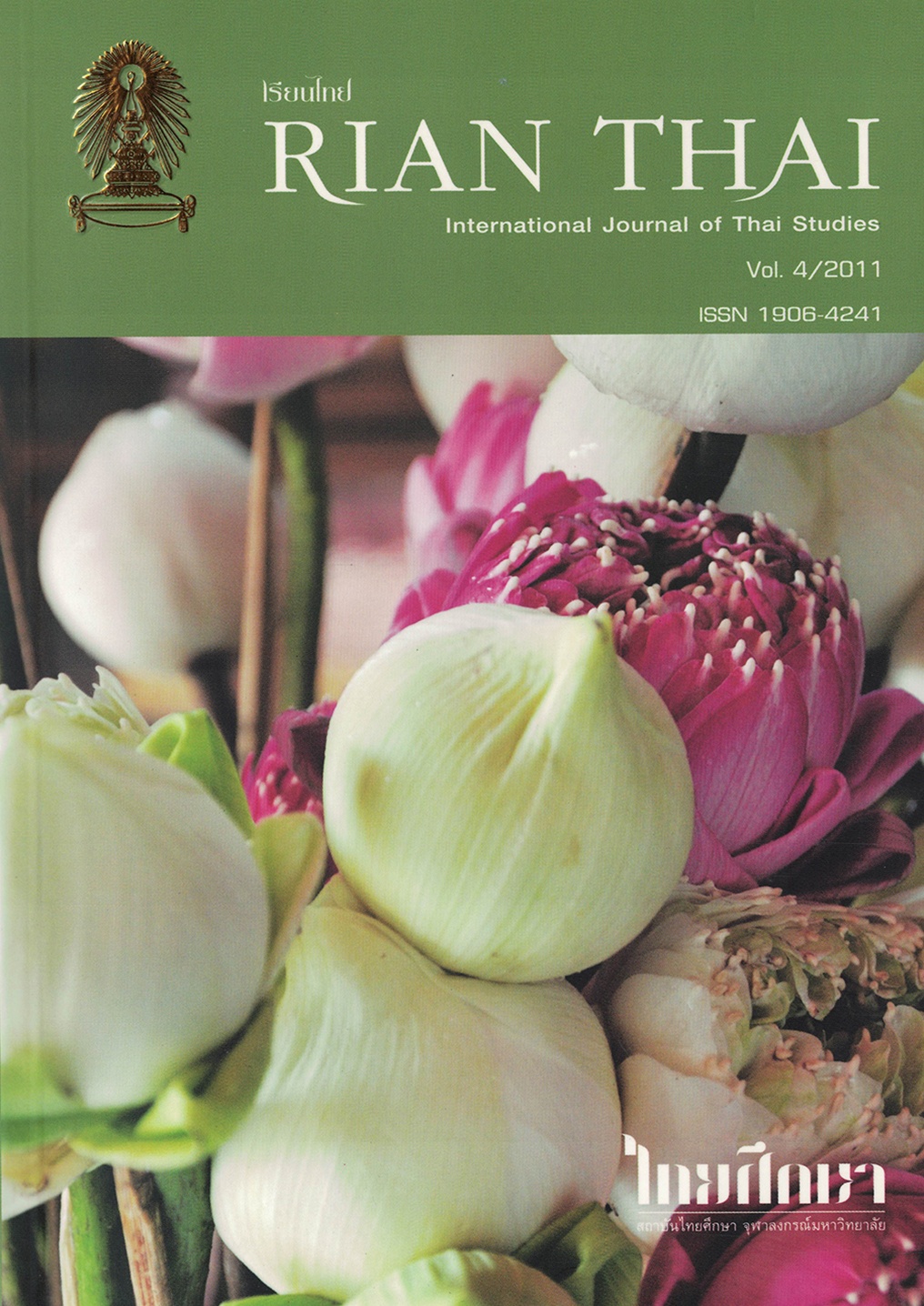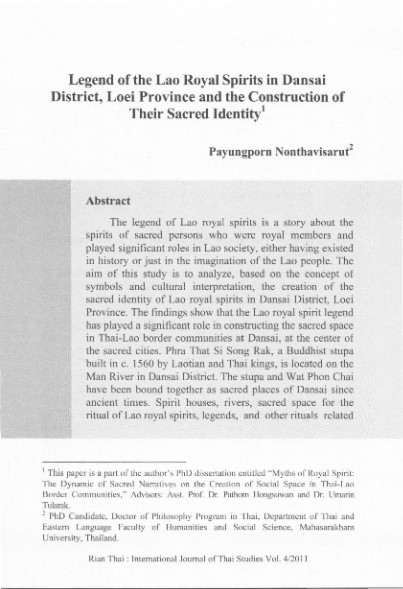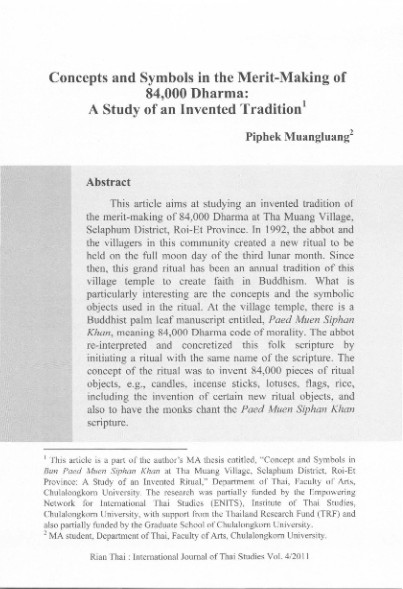Rian Thai - Volume 4/2011

1) From Assembly to Streets : Contentious Politics in Thailand (1992-2010) / Vipapat Sinpeng
2) Bad Buddhist Kings : An Examination of the Ideal Social Order / Betty Nguyen
3) Palladium : The Emerald Buddha and the Scope of The Real / Carlos M. Ross
4) Two Meditation Traditions from Contemporary Thailand : A Summary Overview / Catherine Newell
5) Southern Siam’s Socio-Economic Linkages with Northern British Malaya (1855-1909) / Clarence Ngui Yew Kit
6) Chaomae Song Nang Worship Ceremony : The Rite that Unites the Vietnamese and Thai peoples of Mukdahan Province / Panupong Udomsilp
7) Examining and Analyzing the Meditation System Passed Down by the Supreme Patriarch Suk Kaithuean, Now Taught at Wat Ratchasittharam / Patrick Ong Pei Wen
8) Legend of the Lao Royal Spirits in Dansai District, Loei Province and the Construction of Their Sacred Identity / Payungporn Nonthavisarut
9) Concepts and Symbols in the Merit-Making of 84,000 Dharma : A Study as an Invented Tradition / Piphek Muangluang
10) “Face” Conflict and Conflict Resolution in Thai-Japanese MNCs in Thailand / Pornrung Katejulasriroj
From Assembly to Streets : Contentious Politics in Thailand (1992-2010)
Vipapat Sinpeng
Abstract
Under what conditions do politicians take extra-parliamentarian options to get what they want? Why do politicians engage in street politics? This article examines two major episodes of contentious politics in Thailand, Black May of 1992 and the Yellow Shirts vs. Red Shirts (2005-2010), both of which were supported by members of Parliament. The main hypothesis suggests that MPs engage in street politics when parliamentarian options to affect change or to check the power of the executives are foreclosed. Politicians pursue street politics as a strategy to enhance their own bargaining leverage vis-a-vis their legislative counterparts. Whether or not MPs engage in contentious politics depends upon three important factors: a) MPs' degree of agenda setting power within the legislature, b) the cost of mobilizing political support and c) the expected payoff of policy outcome. The case of Thailand will demonstrate that parliamentarians resort to street politics when the benefits (payoffs) are greater than costs (mobilization and agenda powers). Lessons from the Thai case may challenge existing literature on social movements, which presupposes the bottom-up process, by suggesting that, in fact, the elite-mass relationship, as related to movements, is the reverse. Furthermore, the Thai movements can provide valuable lessons as to the challenges of newly democratizing states.
(Published in Rian Thai: International Journal of Thai Studies, Volume 4/2011, Page 1-25)
Full Text : Download
Bad Buddhist Kings : An Examination of the Ideal Social Order
Betty Nguyen
Abstract
Sacral kingship in Thai Buddhism has been a topic of many scholarly tomes that draw mainly upon the scriptural myth of the world conqueror king and the history of central Thai (Tai) kingdoms. Because of a bias in the sources, an elitist monarchial view of Buddhist kingship emerges from these works. It is presumed that the religious were nothing but devoted loyal subjects of historical kings. However, there have been historical periods and places in which Buddhists expressed discontent over kings. In the northern Thai (Tai) principalities from the nineteenth to mid-twentieth centuries, we fmd prophetic literature a vision of a dystopic world, not ordered, but thrown into social and political chaos and profoundly immoral. Traditionally, the righteous ruler maintained the social and moral order. Order depended upon the king to live up to the moral paradigm of Buddhist kingship. However, Buddhist prophetic writings speak about the chaotic world that emerges under the leadership of failed evil kings. In my approach to prophetic literature, I examine the concept of the bad king and the consequences of such a sovereign as conveyed in some of the writings from this literary genre. Through an examination of chaos and un-ideal kings, I seek to refine our notion of what the ideal king meant to Buddhists.
(Published in Rian Thai: International Journal of Thai Studies, Volume 4/2011, Page 27-45)
Full Text : Download
Palladium : The Emerald Buddha and the Scope of The Real
Carlos M. Ross
Abstract
To talk about 'the real' is to talk about those things that constitute our reality. Although such a set might seem universally obvious, certain items have the power to destabilize that basic metaphysical footing. This article presents an inductive exploration of the limits of reality through the analysis of one of those items: the Emerald Buddha [พระแก้วมรกต], palladium of Thailand. Drawing on landmarks of European philosophy and Theravada thinking regarding metaphysics, the argument confronts the theoretical approach to reality with the practical intricacies of cosmic understanding, as found in contemporary Thai society. It is argued that a comprehensive picture of reality demands a way of thinking based on personal perspective, where the predominance of the persona over the collective does not hinder, but reframes, the fundamental sense of togetherness.
(Published in Rian Thai: International Journal of Thai Studies, Volume 4/2011, Page 47-80)
Full Text : Download
Two Meditation Traditions from Contemporary Thailand : A Summary Overview
Catherine Newell
Abstract
This article explores two meditation practices from contemporary Thailand: the vijja dhammakaya which is associated particularly with Wat Paknam and Wat (Phra) Dhammakaya, and the samatha-vipassanna attributed to former Supreme Patriarch, Suk Kai Thuean (1733-1822) of Wat Ratchasittharam, Thonburi. Both these practices are remarkable in that they contain elements which conflict with what is generally considered to be mainstream Theravada meditation. This article explores the emergence and history of the two practices, their current spread and a summary description of their salient features, considering common elements and possible areas of overlap. The article concludes by suggesting directions for further research, arguing that scholarly enquiry into meditation traditions needs to move beyond text-based assessments and can only be enriched by knowledge of context and lineage.
(Published in Rian Thai: International Journal of Thai Studies, Volume 4/2011, Page 81-110)
Full Text : Download
Southern Siam’s Socio-Economic Linkages with Northern British Malaya (1855-1909)
Clarence Ngui Yew Kit
Abstract
This article studies regional changes in an era when British Colonialism in the Malay Archipelago met an increasingly assimilative Siamese Government under King Rama V (Chulalongkorn). In this article, I am suggesting a new framework – to connect the Southern Siamese states of Songkhla, Trang and Phuket with the Northern Malay States of Setul, Kedah and Perlis via the British commercial hub of Penang. If national history has a propensity to tell the history of Thailand and Malaysia separately, the approach that I am suggesting is to look at regional and local history in terms of inter-connectivity of the British, Siamese, Chinese and the Malays. In the 19th century, the geographical position of Southern Siam and Northern British Malaya created a unique flux of political, economic and socio linkages. I argue these linkages can be explained via three perspectives – 1) the formation of regional business and economic networks, 2) trans-border political loyalty, and 3) a shared social-cultural affiliation. Given that local studies of Penang and Phuket are rare, this comparative study of both areas will contribute significantly to the research on Southern Thailand and its linkages to the central power-base of Bangkok. Moreover, the Phuket-Penang connection is among the least-explored themes of Thai-Malaysian history and a warrants well-deserved other look.
(Published in Rian Thai: International Journal of Thai Studies, Volume 4/2011, Page 111-136)
Full Text : Download
Chaomae Song Nang Worship Ceremony : The Rite that Unites the Vietnamese and Thai peoples of Mukdahan Province
Panupong Udomsilp
Abstract
This research aims to examine the process of social adaptation through participation in the Chaomae Song Nang worship ceremony that unites the Vietnamese and Thai people in Muang Mukdahan District of Mukdahan Province. It was found that the Vietnamese refugees in Mukdahan Province who become Chaomae Song Nang disciples and participated in the annual worship ceremony are accepted by the people of Muang Mukdahan community to a greater degree than the refugees who did not participate in the ceremony. This worship ceremony, therefore, has had a significant role in unifying people of various ethnic groups who participate in this sacred communal rite.
(Published in Rian Thai: International Journal of Thai Studies, Volume 4/2011, Page 137-153)
Full Text : Download
Examining and Analyzing the Meditation System Passed Down by the Supreme Patriarch Suk Kaithuean, Now Taught at Wat Ratchasittharam
Patrick Ong Pei Wen
Abstract
This article examines the living tradition of the meditation system inherited from the Venerable Suk Kaithuean at Wat Ratchasittharam. It is believed that Venerable Suk belonged to a lineage of forest monks whose meditation practices were passed down over many centuries from the historical Buddha and his son Rahul. When he was appointed the abbot of Wat Ratchasittharam, the Venerable Suk played an important role in contributing to the establishment of the early Bangkok period. He was the head of meditation instruction during the reign of King Rama I and held the appointment of the Supreme Patriarch under King Rama II. During this period, his method of meditation was promoted throughout the kingdom. Two hundred years later, the meditation system as propagated by the Venerable Suk can hardly be found in the modem Thailand. Today, it is named Matchima meditation and is only taught at Wat Ratchasittharam. My aim is to provide a holistic understanding of this ancient, but living tradition.
This article addresses an understanding of the meditation system in terms of its philosophy, techniques and how it is currently practiced, as well as provides a background understanding of the practitioners. This article also addresses the discourse used by the practitioners that justify their commitment to the practice and how they see it vis-a-vis other contemporary meditation systems in Thailand.
(Published in Rian Thai: International Journal of Thai Studies, Volume 4/2011, Page 155-189)
Full Text : Download
Legend of the Lao Royal Spirits in Dansai District, Loei Province and the Construction of Their Sacred Identity
Payungporn Nonthavisarut
Abstract
The legend of Lao royal spirits is a story about the spirits of sacred persons who were royal members and played significant roles in Lao society, either having existed in history or just in the imagination of the Lao people. The aim of this study is to analyze, based on the concept of symbols and cultural interpretation, the creation of the sacred identity of Lao royal spirits in Dansai District, Loei Province. The findings show that the Lao royal spirit legend has played a significant role in constructing the sacred space in Thai-Lao border communities at Dansai, at the center of the sacred cities. Phra That Si Song Rak, a Buddhist stupa built in c. 1560 by Laotian and Thai kings, is located on the Man River in Dansai District. The stupa and Wat Phon Chai have been bound together as sacred places of Dansai since ancient times. Spirit houses, rivers, sacred space for the ritual of Lao royal spirits, legends, and other rituals related to the spirits, are symbols reflecting the cultural communication through persons, ritual priority, and timing. Tradition, ritual, color, costume, and language are the symbols indicating power, social class, mental culture, kinship relation, and the practice rules for the ancient Lao royal members. These symbols are the factors for creating the sacred space of spirits linking the state relationship across the geographical border.
(Published in Rian Thai: International Journal of Thai Studies, Volume 4/2011, Page 191-216)
Full Text : Download
Concepts and Symbols in the Merit-Making of 84,000 Dharma : A Study as an Invented Tradition
Piphek Muangluang
Abstract
This article aims at studying an invented tradition of the merit-making of 84,000 Dharma at Tha Muang Village, Selaphum District, Roi-Et Province. In 1992, the abbot and the villagers in this community created a new ritual to be held on the full moon day of the third lunar month. Since then, this grand ritual has been an annual tradition of this village temple to create faith in Buddhism. What is particularly interesting are the concepts and the symbolic objects used in the ritual. At the village temple, there is a Buddhist palm leaf manuscript entitled, Paed Muen Siphan Khan, meaning 84,000 Dharma code of morality. The abbot re-interpreted and concretized this folk scripture by initiating a ritual with the same name of the scripture. The concept of the ritual was to invent 84,000 pieces of ritual objects, e.g., candles, incense sticks, lotuses, flags, rice, including the invention of certain new ritual objects, and also to have the monks chant the Paed Muen Siphan Khan scripture.
This article will identify the various concepts behind this merit-making, arguing that, in inventing this new tradition, the abbot combines Buddhist concepts with local beliefs. Moreover, this article will analyze the ritual symbols, including both the ritual objects and the ritual acts, and argue that the ritual symbols represent Buddhist Dharma, supernaturalism, fertility and Thai folk life. The merit-making of 84,000 Dharma indicates the role of Buddhism in Thai folk life, and helps to understand a kind of Thai Buddhism that is a syncretism between Buddhism, Brahmanism and the indigenous beliefs in supernaturalism.
(Published in Rian Thai: International Journal of Thai Studies, Volume 4/2011, Page 217-235)
Full Text : Download
“Face” Conflict and Conflict Resolution in Thai-Japanese MNCs in Thailand
Pornrung Katejulasriroj
Abstract
The purpose of this study was to test the argument that "face" is a fundamental cause of interpersonal conflict and explore the similarities and differences of conflict resolution between Thai and Japanese MNCs participants. Additionally, the correlation between face concerns and conflict management styles of the two cultures was examined. The research explored the Face-Negotiation theory (FN) version 2 to test that "face" is an underlying assumption and/or an explanatory mechanism for conflicts in the organization. The adapted version of Rahim Organization Conflict Inventory-IT (ROCI-II) was employed to test the differences and similarities of conflict management styles.
The findings of this research illustrated that "face" is a fundamental cause of interpersonal conflict for Thai and Japanese participants. Thais rated themselves higher for all types of face concerns: self-face, other-face, and mutual-face, than Japanese. Regarding the similarities and differences of conflict resolution, Thai participants preferred using integrating, avoiding, obliging and compromising more than Japanese participants. The relationship between face concerns and conflict management style showed that the more self-face and otherface concerned the Thai participants were, the more they reported using obliging. Additionally, the more mutual-faced concerned they were, the more they reported using integrating. Whereas for Japanese participants, the more self-face concerned they were, the more they reported using dominating. Additionally, the more other-face concerned and the more mutual-face concerned they were, the more they reported using integrating.
(Published in Rian Thai: International Journal of Thai Studies, Volume 4/2011, Page 237-263)
Full Text : Download

%20ocr.pdf.jpg?alt=media&token=2f3783e1-9e03-487a-9b0f-14cc9c901c5c)



%20ocr.pdf.jpg?alt=media&token=b26df84a-1f13-4a0e-9826-bf3a6b71c24d)




